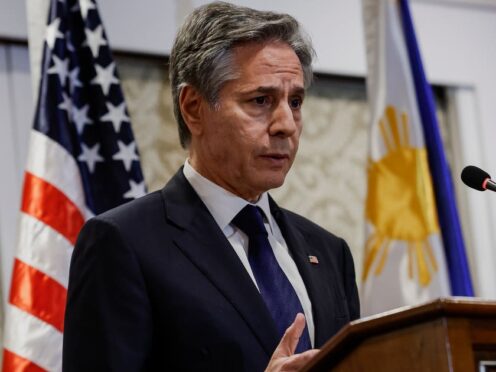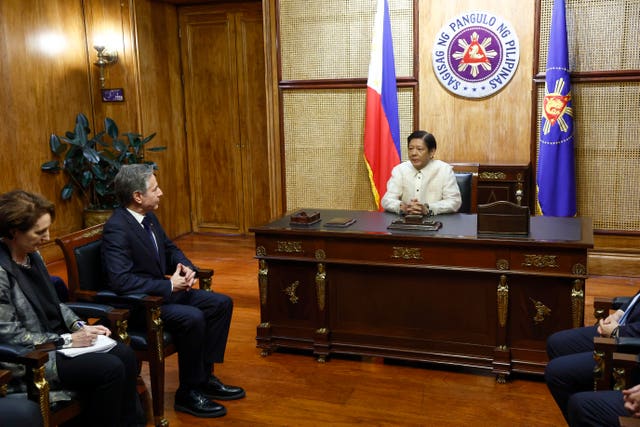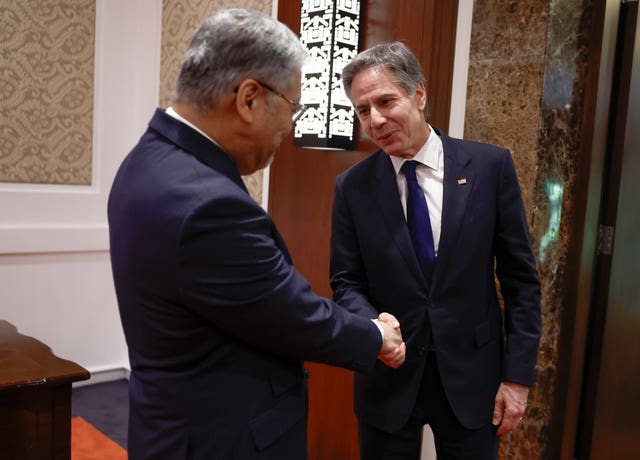
Secretary of State Antony Blinken has spoken of Washington’s “ironclad commitment” to defend the Philippines after clashes between Chinese and Filipino coastguards in the disputed South China Sea.
Mr Blinken, the latest high-level official to visit the United States ally, met his Philippine counterpart Enrique Manalo on Tuesday before planned meetings with President Ferdinand Marcos Jr and other top officials in Manila.
President Joe Biden will host Mr Marcos and Japanese Prime Minister Fumio Kishida at a White House summit in April.
The three are likely to discuss concerns over increasingly aggressive Chinese actions in the South China Sea and North Korea’s nuclear programme.

“We stand with the Philippines and stand by our ironclad defence commitments, including under the Mutual Defence Treaty,” Mr Blinken said at a news conference with Mr Manalo.
“We have a shared concern about the PRC’s actions that threaten our common vision for a free, open Indo-Pacific, including in the South China Sea and in the Philippines’ exclusive economic zone,” Mr Blinken said, using the abbreviation for the People’s Republic of China.
He cited “repeated violations of international law and the rights of the Philippines: water cannons, blocking manoeuvres, close shadowing other dangerous operations”.
The Chinese coast guard blocked and used water cannons against Philippine vessels in a confrontation two weeks ago that slightly injured a Filipino admiral and four of his sailors near the disputed Second Thomas Shoal.
The March 5 incident also caused two minor collisions between Chinese and Philippine vessels and prompted Manila’s Department of Foreign Affairs to summon China’s deputy ambassador to convey a protest against the Chinese coast guard’s actions, which the Philippines said were unacceptable.
The Chinese coast guard said that “it took control measures in accordance with the law against Philippine ships that illegally intruded into the waters adjacent to Ren’ai Reef”, the name Beijing uses for Second Thomas Shoal.
The Second Thomas Shoal, which is occupied by a small Philippine navy contingent but surrounded by Chinese coast guard ships and other allied vessels, has been the site of several tense skirmishes between Chinese and Philippine coast guard ships in the past year.

But Filipino officials said the confrontation earlier this month was particularly serious because of the injuries sustained by its navy personnel and damage to their vessel.
Mr Blinken renewed a warning on Tuesday that the US is obliged under a 1951 Mutual Defence Treaty to defend the Philippines if Filipino forces, ships or aircraft come under an armed attack anywhere in the South China Sea.
Both Mr Blinken and Mr Manalo described their countries’ treaty alliance as being on “hyper-drive” but acknowledged that more could be done. They said efforts to shore up defence ties were not aimed against any country.
Beijing has repeatedly said that Mr Marcos’s decision to allow the expansion of an American military presence in the Philippines under a 2014 defence pact could undermine the security of China and the region.
US and Philippine forces plan to hold their largest annual combat exercises in April in the Philippines. The area would include a northern region not far from Taiwan, which China claims as its own territory.
“We reaffirmed our shared view that a strong and capable Philippines would make a formidable ally for the United States,” Mr Manalo said.

Enjoy the convenience of having The Sunday Post delivered as a digital ePaper straight to your smartphone, tablet or computer.
Subscribe for only £5.49 a month and enjoy all the benefits of the printed paper as a digital replica.
Subscribe